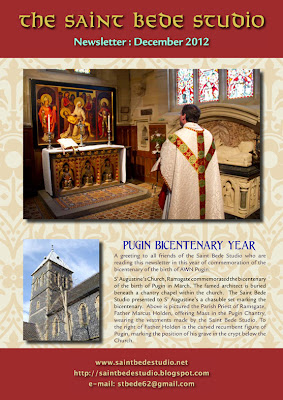 |
| Saint Augustine's Church, Ramsgate Photograph: Fr Tim Finnigan. |
Almost everything of this building was designed by Pugin himself, including the vestments. In the 1970s, however, a decision was taken to give the large collection of vestments and paraments into the care of the Victoria & Albert Museum in London.
The Friends of Saint Augustine was established in 2010 to support the restoration and repair of Saint Augustine's church (and its associated buildings) and to promote greater awareness of its architectural and historical importance.
 In conjunction with the Friends of Saint Augustine, the Saint Bede Studio is organising a SPECIAL APPEAL to provide - over a period of years - new vestments in the Puginesque style for Saint Augustine's church. Wherever possible, these new vestments will be similar to the original Pugin vestments, now in the V & A Museum. The first design is shewn adjacent and is derived from two different original Pugin vestments.
In conjunction with the Friends of Saint Augustine, the Saint Bede Studio is organising a SPECIAL APPEAL to provide - over a period of years - new vestments in the Puginesque style for Saint Augustine's church. Wherever possible, these new vestments will be similar to the original Pugin vestments, now in the V & A Museum. The first design is shewn adjacent and is derived from two different original Pugin vestments.
Are you an admirer of Pugin and his work? If so, this is your opportunity to make a donation to the church which was his last great work and his place of earthly rest. If you are interested in making a donation to this Project, or to obtain further information, please contact us by e-mail, using the subject line Ramsgate Vestments Appeal.
When sufficient funds have been subscribed to cover costs, the vestment will be made up by the Studio for presentation to Saint Augustine's. Please note: the sole beneficiary of this appeal will be Saint Augustine's Church, Ramsgate and not the Saint Bede Studio.

















































